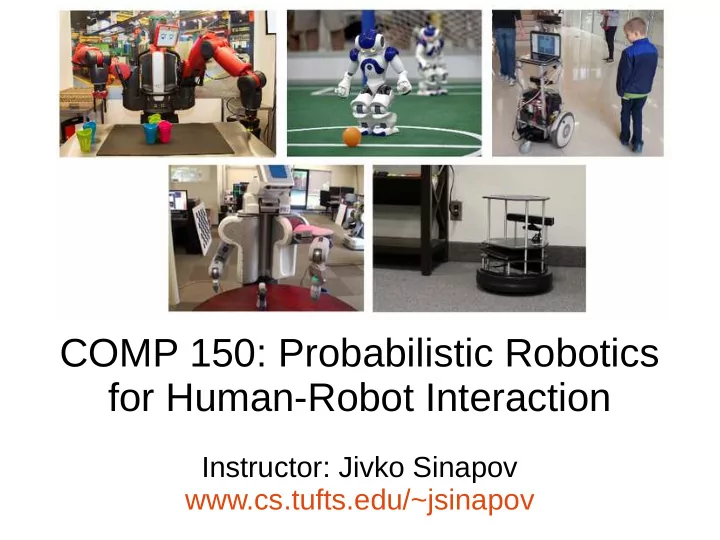

COMP 150: Probabilistic Robotics for Human-Robot Interaction Instructor: Jivko Sinapov www.cs.tufts.edu/~jsinapov
This week: Planning
Announcements
Reading Assignment ● Project Related Article of your choice – If working with a team, each member should read a different article – Summary and link on Canvas – Due 3/24
Proposal Peer Review ● Each student will review 2 proposals, each proposal will receive ~3 reviews ● Look for an email from Tyler with instructions
Planning
Path Planning using A* [from “Making Shakey 1966-1972”]
Planning for Manipulation [http://arm.eecs.umich.edu/]
Whole-Body Motion Planning
Whole-Body Motion Planning
Planning with Symbols
Teleoperation
Teleoperation
Teleoperation
Teleoperation
Teleoperation
Teleoperation
Robotics Timeline
Teleoperation vs Telepresence ● An early attempt to improve teleoperation was to add more cameras / displays ● Telepresence aims for placing the operator in a virtual reality that mimics the robot's surroundings
Telepresence Robots http://www.pilotpresence.com/wp-content/uploads/2011/01/remote-presence-systemsv2.jpg
The need for (semi-) autonomy
How should autonomy be achieved and organized?
Robot Primitives
The Early Answer (1967): Sense-Plan-Act
The Early Answer (1967): Sense-Plan-Act
Early Example of S-P-A
Shakey Video
Early Work on Planning
Early Work on Planning
Early Work on Planning
A More Realistic Example
A More Realistic Example A More Realistic Example
A More Realistic Example IT Is INROOM(IT,R1) true or false? CONNECTS(D1,R1,R2)? INROOM(IT,R2)?
Representing Initial State IT
Representing Goal State IT
The “difference” table
Logical Difference or
Finding the Plan
Discussion ● How did you solve the problem? ● What are some limitations of planning with STRIPS? ● Where do the predicates, operators, etc. come from?
Towers of Hanoi with PDDL [ https://s3.amazonaws.com/ka-cs-algorithms/hanoi-5-init.png ]
3-Disk Hanoi
Final Plan
PDDL ● Editor: http://editor.planning.domains/ ● Tutorial: https://www.cs.toronto.edu/~sheila/2542/s14/A1/ introtopddl2.pdf ● Example PDDL files: http://www.ida.liu.se/%7ETDDC17/info/labs/plann ing/strips/
Actions ● Action name and parameters: ● Preconditions: ● Effects:
Planning Exercise ● Consider a service robot operating in a human environment such as an office or our department ● Specify three high-level actions, with preconditions and end-effects – You will need to specify the relevant predicates as well – Specify a planning problem within the domain
Further Reading ● Planning with STRIPS: A gentle introduction http://www.primaryobjects.com/2015/11/06/artifici al-intelligence-planning-with-strips-a-gentle-int roduction/ ● Cashmore, Michael, et al. " ROSplan: Planning in the robot operating system. " Twenty-Fifth International Conference on Automated Planning and Scheduling. 2015.
Next time...planning in stochastic domains
THE END
Recommend
More recommend